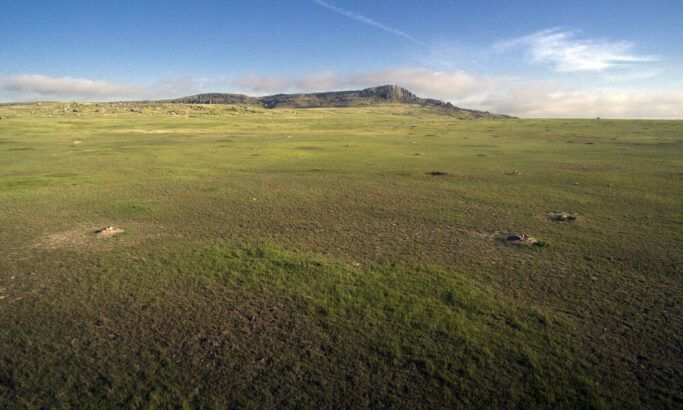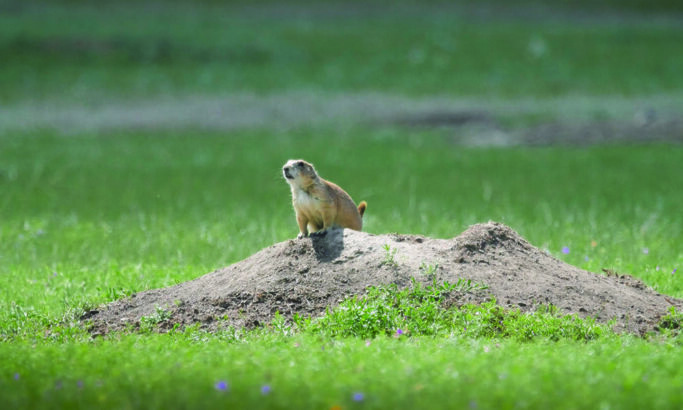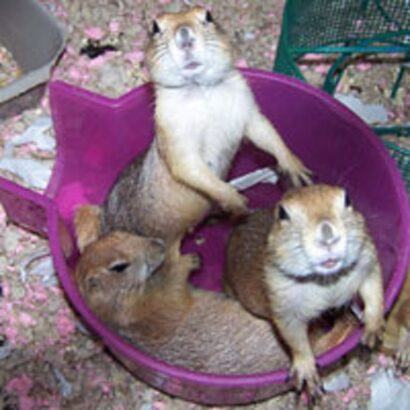Hi guys, I couldn’t resist sharing this with you. Lisa Burns, one of our long-time, loyal members and the noble founder of the Farmhouse Animal & Nature Sanctuary, recently posted a pic of Luna, a ridiculously cute prairie dog, in our Good Old Doggie Facebook Group. I’m embarrassed to admit that I had no idea if Luna was a dog, a rodent, a bird, whatever? So, Google informed me that prairie dogs are a type of squirrel! The thing is, Luna behaves more like a human than an animal. So, I went hunting for some info and came up with many interesting facts about this most interesting and intelligent “dog.” Here’s what worldwildlife.org has to report:
8 surprising prairie dog facts
Exploring the complex world of the peculiar critters of America’s grasslands
AUTHOR: Sarah Wade
Prairie dogs tend to be celebrated for their larger ecological virtues. In the grasslands across the central and western United States, their intricate underground colonies—called prairie dog towns—create shelter for jackrabbits, toads, and rattlesnakes. The bare patches of ground created by their grazing and burrowing attract certain insects that feed a variety of birds. And prairie dogs themselves are a key food source for everything from coyotes to hawks to endangered black-footed ferrets.
“These animals support at least 136 other species through their various activities,” said Kristy Bly, a WWF senior wildlife conservation biologist. “They’re basically the Chicken McNuggets of the grasslands.”
But these small, chubby-looking mammals are also fascinating in their own right. Check out these facts for a glimpse into their strange, surprisingly complex world.

-
They’re tough
Prairie dogs may look a bit like actual Chicken McNuggets, but in reality, they’re fast, skilled fighters armed with sharp claws and powerful teeth. “The worst animal bite I’ve ever gotten was from a prairie dog,” said Jessica Alexander, a program associate in WWF’s Northern Great Plains office. “It takes a while for black-footed ferrets to learn how to catch them. Prairie dogs fight back.”
-
Their entire mating season is just an hour long
In contrast with popular perceptions of prairie dogs as fast-multiplying rodents, these animals actually mate just once a year, in early winter. Females go into estrus for a single hour. They then have litters of three to eight pups—usually only half of which survive their first year.

-
They live in tight-knit family groups called coteries
The average coterie tends to have one or two breeding males, several breeding females, and the females’ new pups. Males tend to jump from coterie to coterie—but the females stick together for life.
-
Their vocabulary is more advanced than any other animal language that’s been decoded
To a human ear, prairie dogs’ squeaky calls sound simple and repetitive. But recent research has found that those calls can convey incredibly descriptive details. Prairie dogs can alert one another, for example, that there’s not just a human approaching their burrows but a tall human wearing the color blue.

-
They are cousins of the squirrels in your backyard
All five species of prairie dog belong to the Sciuridae(squirrel) family. Their other biological relatives include groundhogs, chipmunks, marmots, and woodchucks.
-
Their historical range has shrunk by more than 95%
There used to be hundreds of millions of prairie dogs in North America. European settlers traveling through the West wrote about passing through massive prairie dog colonies, some of which extended for miles. But over time, their range has shrunk to less than 5% of its original extent due to a host of pressures, including habitat encroachment by humans.

-
They’re threatened by the same plague that caused the Black Death in Europe
In the late 1800s, the bubonic plague entered North America via rats aboard European ships. It quickly spread through wild mammal populations, including black-tailed prairie dogs in the northern Great Plains. The disease is still rampant in large tracts of the region and tends to wipe out entire prairie dog colonies when it strikes.
-
Black-footed ferrets depend on prairie dogs—and we’re working to protect both species
Prairie dogs are the primary source of food and habitat for endangered black-footed ferrets. At Fort Belknap Indian Reservation in Montana, WWF is collaborating with tribal partners to monitor the health of prairie dog colonies where black-footed ferrets live—and identify new areas where ferrets could be released. In September 2015, new ferrets were released into a healthy prairie dog colony and quickly darted down the holes.
Help support these grassland critters. Adopt a prairie dog.
Click here for more fun facts about prairie dogs, “the barking squirrels”
Written by Lisa Burns (Luna’s mom)
Be sure to check out the rest of the posts on Good Old Doggie for more interesting info, tips, and fun!




Great information! Thanks for sharing our special girl Luna
It was my pleasure! She’s so cute!
Was fun knowledge
Thanks, Judith! It was fun to learn about those little guys.